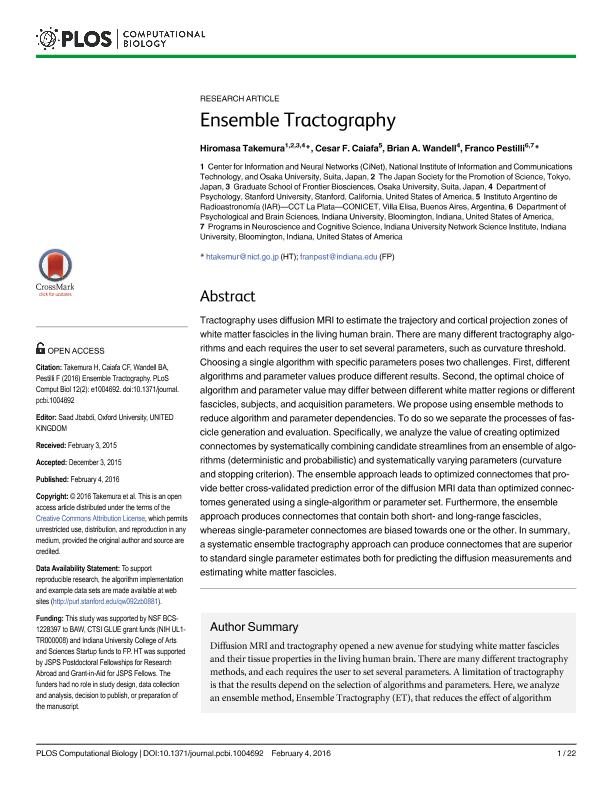Mostrar el registro sencillo del ítem
dc.contributor.author
Takemura, Hiromasa
dc.contributor.author
Caiafa, César Federico

dc.contributor.author
Wandell, Brian A.
dc.contributor.author
Pestilli, Franco
dc.date.available
2017-09-18T14:58:59Z
dc.date.issued
2016-02
dc.identifier.citation
Takemura, Hiromasa; Caiafa, César Federico; Wandell, Brian A.; Pestilli, Franco; Ensemble tractography; Public Library of Science; Plos Computational Biology; 12; 2; 2-2016; 1-22; e1004692
dc.identifier.issn
1553-734X
dc.identifier.uri
http://hdl.handle.net/11336/24450
dc.description.abstract
Fiber tractography uses diffusion MRI to estimate the trajectory and cortical projection zones of white matter fascicles in the living human brain. There are many different tractography algorithms and each requires the user to set several parameters, such as curvature threshold. Choosing a single algorithm with a specific parameters sets poses two challenges. First, different algorithms and parameter values produce different results. Second, the optimal choice of algorithm and parameter value may differ between different white matter regions or different fascicles, subjects, and acquisition parameters. We propose using ensemble methods to reduce algorithm and parameter dependencies. To do so we separate the processes of fascicle generation and evaluation. Specifically, we analyze the value of creating optimized connectomes by systematically combining candidate fascicles from an ensemble of algorithms (deterministic and probabilistic) and sweeping through key parameters (curvature and stopping criterion). The ensemble approach leads to optimized connectomes that provide better cross-validatedprediction error of the diffusion MRI data than optimized connectomes generated using the singlealgorithms or parameter set. Furthermore, the ensemble approach produces connectomes that contain both short- and long-range fascicles, whereas single-parameter connectomes are biased towards one or the other. In summary, a systematic ensemble tractography approach can produce connectomes that are superior to standard single parameter estimates both for predicting the diffusion measurements and estimating white matter fascicles.
dc.format
application/pdf
dc.language.iso
eng
dc.publisher
Public Library of Science

dc.rights
info:eu-repo/semantics/openAccess
dc.rights.uri
https://creativecommons.org/licenses/by/2.5/ar/
dc.subject
Tractography
dc.subject
Human Connectome
dc.subject
Magnetic Resonance
dc.subject.classification
Otras Ciencias de la Computación e Información

dc.subject.classification
Ciencias de la Computación e Información

dc.subject.classification
CIENCIAS NATURALES Y EXACTAS

dc.title
Ensemble tractography
dc.type
info:eu-repo/semantics/article
dc.type
info:ar-repo/semantics/artículo
dc.type
info:eu-repo/semantics/publishedVersion
dc.date.updated
2017-09-01T18:27:19Z
dc.journal.volume
12
dc.journal.number
2
dc.journal.pagination
1-22; e1004692
dc.journal.pais
Estados Unidos

dc.journal.ciudad
San Francisco
dc.description.fil
Fil: Takemura, Hiromasa. University of Stanford; Estados Unidos. Osaka University; Japón
dc.description.fil
Fil: Caiafa, César Federico. Provincia de Buenos Aires. Gobernación. Comisión de Investigaciones Científicas. Instituto Argentino de Radioastronomía. Consejo Nacional de Investigaciones Científicas y Técnicas. Centro Científico Tecnológico Conicet - La Plata. Instituto Argentino de Radioastronomía; Argentina
dc.description.fil
Fil: Wandell, Brian A.. University of Stanford; Estados Unidos
dc.description.fil
Fil: Pestilli, Franco. Indiana University; Estados Unidos
dc.journal.title
Plos Computational Biology

dc.relation.alternativeid
info:eu-repo/semantics/altIdentifier/url/http://journals.plos.org/ploscompbiol/article?id=10.1371/journal.pcbi.1004692
dc.relation.alternativeid
info:eu-repo/semantics/altIdentifier/doi/http://dx.doi.org/10.1371/journal.pcbi.1004692
Archivos asociados
